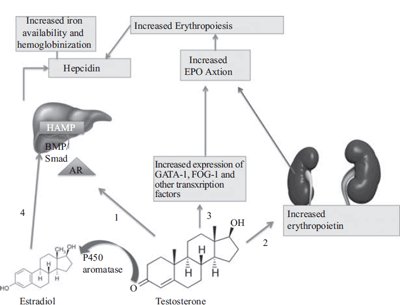BES2018 BES 2018 A rare cause of polycythemia in an octogenarian (1 abstracts)
A rare cause of polycythemia in an octogenarian
Bahar Nabila , Corvilain Bernard & Driessens Natacha
Department of Endocrinology, Hôpital Erasme, UniversitéLibre de Bruxelles, Bruxelles, Belgium.
An 82-year-old woman with a history of breast carcinoma and hypertension underwent right laparoscopic adrenalectomy for a large mass (7×5 cm) of high density without contrast (>30 UH), non-secreting. Anatomapathological examination concluded to an adrenocortical adenoma without signs of malignancy: Weiss score of 2 and Ki67 <2%. Two years later, she developed polycythemia (Hb: 17.9 g/dl (N: 11.8–15.5); hematocrit: 53.5% (N: 35.3–46.1)) without involvement of other hematopoietic lineages. EPO level was in the normal range (13.5 U/l (N: 3.1–17)) and no JAK2 mutation was detected. A few months later, she complained of unusual hair on arms and face and weight gain. Clinical examination revealed signs of hypercortisolism: fatty supraclavicular fullness, dorsal fat pad, ecchymosis and muscular atrophy. Hormonal evaluation demonstrated severe hyperandrogenemia (total testosterone: 28.3 nmol/l (N: 0.50–1.67); DHEAs> 27.0 μmol/l (N: 0.33–4.18); androstenedione: 18.0 ng/ml (N: 0.1–3.0)) and hypercortisolism (no inhibition of plasma cortisol by 1 mg overnightdexamethasone test and urinary free cortisol (UFC) at three-fold the upper limit of reference range). Abdominal imaging showed local tumour recurrence in right adrenalectomy sitewith distant peritoneal metastases. Ketoconazole therapy was initiated to control excessive cortisol secretion. Four months after diagnosis, despite Ketoconazole therapy, UFC increased to 3400 nmol/24 h (N: 100–379). Because of uncontrolled hypercortisolism and patient’s choice, surgical resection was finally performed after 7 days of continuous intravenous infusion of Etomidate at the dose of 0.3 mg/kg per hour. Androgens levels and UFC returned to normal after a large debulking. Remarkably, Ki67 was also <2% in the resected tumour but many criteria of malignancy scoring systems were observed: marked atypical mitoses, confluent necrosis, venous invasion. While polycythemia is a well-known side effect of excessive exogenous androgens or anabolic steroids intake, it is an unusual manifestation in adrenal carcinoma secreting androgens.Testosterone-induced increase in hemoglobin and hematocrit is associated with stimulation of erythropoietin (EPO) secretion and reduced hepcidin concentrations. In our case, EPO level was inappropriately normal-high in the presence of a secondary erythrocytosis suggesting a possible EPO-producing tumour. However, it is impossible to distinguish an increase in EPO due to a tumor production or due to an increase renal production induced by testosterone excess. This case illustrates well the limits of clinical and prognostic value of malignancy scoring system such Weiss score and the need to identify new markers of aggressiveness (maybe EPO-producing by the tumour?) and therefore the importance of a complete anatomo-clinical characterization and the need multidisciplinary management for rare tumours such as adrenal carcinoma.

Reference: Bachman E et al. Testosterone induces erythrocytosis via increased erythropoietin and suppressed hepcidin: evidence for a new erythropoietin/hemoglobin set point. J Gerontol A Biol Sci Med Sci 2014 June;69(6):725–735.




